Weather satellite
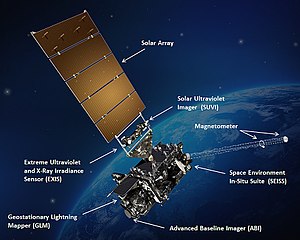
A weather satellite or meteorological satellite is a type of
While primarily used to detect the development and movement of storm systems and other cloud patterns,
have also been monitored.History

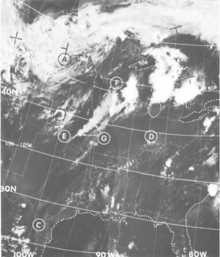
As early as 1946, the idea of cameras in orbit to observe the weather was being developed. This was due to sparse data observation coverage and the expense of using cloud cameras on rockets. By 1958, the early prototypes for TIROS and Vanguard (developed by the Army Signal Corps) were created.[3] The first weather satellite, Vanguard 2, was launched on February 17, 1959.[4] It was designed to measure cloud cover and resistance, but a poor axis of rotation and its elliptical orbit kept it from collecting a notable amount of useful data. The Explorer VI and VII satellites also contained weather-related experiments.[3]
The first weather satellite to be considered a success was TIROS-1, launched by NASA on April 1, 1960.[5] TIROS operated for 78 days and proved to be much more successful than Vanguard 2. TIROS paved the way for the Nimbus program, whose technology and findings are the heritage of most of the Earth-observing satellites NASA and NOAA have launched since then. Beginning with the Nimbus 3 satellite in 1969, temperature information through the tropospheric column began to be retrieved by satellites from the eastern Atlantic and most of the Pacific Ocean, which led to significant improvements to weather forecasts.[6]
The ESSA and NOAA polar orbiting satellites followed suit from the late 1960s onward. Geostationary satellites followed, beginning with the
The
In Europe, the first
The
The
In 2006, the first European low-Earth orbit operational meteorological satellite,
A second generation of Metop satellites (Metop-SG) is in advanced development with launch of the first satellite foreseen in 2025. As with MTG, Metop-SG will launch on Ariane-6 and comprise two satellite models to be operated in pairs in replacement of the single first generation satellites to continue the EPS mission.
Observation
Observation is typically made via different 'channels' of the electromagnetic spectrum, in particular, the visible and infrared portions.
Some of these channels include:[8][9]
- Visible and Near Infrared: 0.6–1.6 μm – for recording cloud cover during the day
- Infrared: 3.9–7.3 μm (water vapor), 8.7–13.4 μm (thermal imaging)
Visible spectrum
Visible-light images from weather satellites during local daylight hours are easy to interpret even by the average person, clouds, cloud systems such as fronts and tropical storms, lakes, forests, mountains, snow ice, fires, and pollution such as smoke, smog, dust and haze are readily apparent. Even wind can be determined by cloud patterns, alignments and movement from successive photos.[10]
Infrared spectrum
The
Types
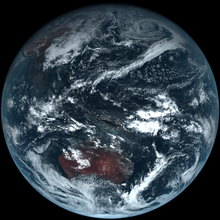
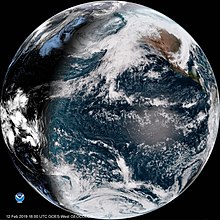
Each meteorological satellite is designed to use one of two different classes of orbit: geostationary and polar orbiting.
Geostationary
Geostationary weather satellites orbit the Earth above the equator at altitudes of 35,880 km (22,300 miles). Because of this orbit, they remain stationary with respect to the rotating Earth and thus can record or transmit images of the entire hemisphere below continuously with their visible-light and infrared sensors. The news media use the geostationary photos in their daily weather presentation as single images or made into movie loops. These are also available on the city forecast pages of www.noaa.gov (example Dallas, TX).[12]
Several geostationary meteorological spacecraft are in operation. The United States' GOES series has three in operation: GOES-15, GOES-16 and GOES-17. GOES-16 and-17 remain stationary over the Atlantic and Pacific Oceans, respectively.[13] GOES-15 was retired in early July 2019.[14]
The satellite GOES 13 that was previously owned by the National Oceanic and Atmospheric Association (NOAA) was transferred to the U.S. Space Force in 2019 and renamed the EWS-G1; becoming the first geostationary weather satellite to be owned and operated by the U.S. Department of Defense.[15]
Polar orbiting

Polar orbiting weather satellites circle the Earth at a typical altitude of 850 km (530 miles) in a north to south (or vice versa) path, passing over the poles in their continuous flight. Polar orbiting weather satellites are in sun-synchronous orbits, which means they are able to observe any place on Earth and will view every location twice each day with the same general lighting conditions due to the near-constant local solar time. Polar orbiting weather satellites offer a much better resolution than their geostationary counterparts due their closeness to the Earth.
The United States has the
DMSP
The
At the same time, energy use and city growth can be monitored since both major and even minor cities, as well as highway lights, are conspicuous. This informs
In addition to monitoring city lights, these photos are a life saving asset in the detection and monitoring of fires. Not only do the satellites see the fires visually day and night, but the thermal and infrared scanners on board these weather satellites detect potential fire sources below the surface of the Earth where smoldering occurs. Once the fire is detected, the same weather satellites provide vital information about wind that could fan or spread the fires. These same cloud photos from space tell the firefighter when it will rain.
Some of the most dramatic photos showed the 600
Uses
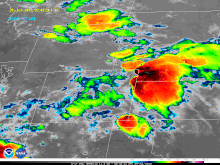
Snowfield monitoring, especially in the
Even pollution whether it is nature-made or human-made can be pinpointed. The visual and infrared photos show effects of pollution from their respective areas over the entire earth. Aircraft and
In remote areas of the world with few local observers, fires could rage out of control for days or even weeks and consume huge areas before authorities are alerted. Weather satellites can be a valuable asset in such situations. Nighttime photos also show the burn-off in gas and oil fields. Atmospheric temperature and moisture profiles have been taken by weather satellites since 1969.[17]
Non-imaging sensors
Not all weather satellites are direct
International regulation
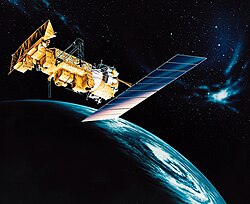
According to the
Classification
This radiocommunication service is classified in accordance with ITU Radio Regulations (article 1) as follows:
Fixed service (article 1.20)
- Fixed-satellite service (article 1.21)
- Inter-satellite service (article 1.22)
- Earth exploration-satellite service(article 1.51)
- Meteorological-satellite service
Frequency allocation
The allocation of radio frequencies is provided according to Article 5 of the ITU Radio Regulations (edition 2012).[19]
In order to improve harmonisation in spectrum utilisation, the majority of service-allocations stipulated in this document were incorporated in national Tables of Frequency Allocations and Utilisations which is with-in the responsibility of the appropriate national administration. The allocation might be primary, secondary, exclusive, and shared.
- primary allocation: is indicated by writing in capital letters (see example below)
- secondary allocation: is indicated by small letters
- exclusive or shared utilization: is within the responsibility of administrations
- Example of frequency allocation
| Allocation to services | ||
Region 1 |
Region 2 | Region 3 |
401-402 MHz METEOROLOGICAL AIDS
| ||
8 817.50-8 821.50 MHz METEOROLOGICAL-SATELLITE (Earth-to-space)
| ||
See also
- Earth observation satellite
- Environmental satellite
- Geostationary orbit
- Kosmos 122
- Low Earth orbit
- Meteorological-satellite radiocommunication service
- Remote sensing
References
- NESDIS. Satellites.[link not working] Retrieved on July 4, 2008. Archived July 4, 2008, at the Wayback Machine
- NOAA. NOAA Satellites, Scientists Monitor Mt. St. Helens for Possible Eruption. Archived September 10, 2012, at archive.todayRetrieved on July 4, 2008.
- ^ ISBN 978-0-87474-394-4.
- ^ "VANGUARD - A HISTORY, CHAPTER 12, SUCCESS - AND AFTER". NASA. Archived from the original on May 9, 2008.
- ^ "U.S. Launches Camera Weather Satellite". The Fresno Bee. AP and UPI. April 1, 1960. pp. 1a, 4a.
- ^ National Environmental Satellite Center (January 1970). "SIRS and the Improved Marine Weather Forecast". Mariners Weather Log. 14 (1). Environmental Science Services Administration: 12–15.
- ^ "DSCOVR: Deep Space Climate Observatory | NOAA National Environmental Satellite, Data, and Information Service (NESDIS)". www.nesdis.noaa.gov. Retrieved August 5, 2021.
- ^ EUMETSAT – MSG Spectrum Archived November 28, 2007, at the Wayback Machine (PDF)
- ^ "EUMETSAT – MFG Payload". Archived from the original on November 25, 2008. Retrieved November 21, 2007.
- ^ A. F. Hasler; K. Palaniappan; C. Kambhammetu; P. Black; E. Uhlhorn; D. Chesters. High-Resolution Wind Fields within the Inner Core and Eye of a Mature Tropical Cyclone from GOES 1-min Images (Report). Retrieved July 4, 2008.
- Retrieved on January 3, 2009.
- ^ Service, US Department of Commerce, NOAA, National Weather. "National Weather Service".
{{cite web}}: CS1 maint: multiple names: authors list (link) - .
- ^ "GOES-17 Transition to Operations │ GOES-R Series". www.goes-r.gov. Retrieved May 26, 2019.
- ^ Balmaseda M, A Barros, S Hagos, B Kirtman, H-Y Ma, Y Ming, A Pendergrass, V Tallapragada, E Thompson. 2020. "NOAA-DOE Precipitation Processes and Predictability Workshop." U.S. Department of Energy and U.S. Department of Commerce NOAA; DOE/SC-0203; NOAA Technical Report OAR CPO-9
- ^ "卫星运行" [Satellite Operation]. National Satellite Meteorological Center of CMA (in Chinese). Archived from the original on August 28, 2015.
- ^ Ann K. Cook (July 1969). "The Breakthrough Team" (PDF). ESSA World. Environmental Satellite Services Administration: 28–31. Archived from the original (PDF) on February 25, 2014. Retrieved April 21, 2012.
- ^ ITU Radio Regulations, Section IV. Radio Stations and Systems – Article 1.52, definition: meteorological-satellite service / meteorological-satellite radiocommunication service
- ^ ITU Radio Regulations, CHAPTER II – Frequencies, ARTICLE 5 Frequency allocations, Section IV – Table of Frequency Allocations
External links
- Theory
- Ralph E. Taggard (1994). Weather satellite handbook (5th ed.). Newington, CT: ISBN 978-0-87259-448-7.
- Cooperative Institute for Meteorological Satellite Studies
- Verner Suomi ("father of the geostationary satellite") biography
- Physical Characteristics of Geostationary and Polar-Orbiting weather satellites
- Data
- Near realtime composite of satellite image of the Earth by Intellicast
- International weather satellite viewer Online geostationary weather satellite viewer with 2 months of archived data.
- Earth at night by NASA
- EUMETSAT – the European Organisation for the Exploitation of Meteorological Satellites
- NASA Langley Cloud and Radiation Research Near real-time and archived satellite imagery and cloud products.
- ISCCP Global ISCCP B1 Browse System (GIBBS) http://www.ncdc.noaa.gov/gibbs/
- Government policy
- Geostationary Weather Satellites: Progress Made, but Weaknesses in Scheduling, Contingency Planning, and Communicating with Users Need To Be Addressed: Report to the Committee on Science, Space, and Technology, House of Representatives Government Accountability Office
- Polar Weather Satellites: NOAA Identified Ways to Mitigate Data Gaps, but Contingency Plans and Schedules Require Further Attention: Report to the Committee on Science, Space, and Technology, House of Representatives Government Accountability Office
